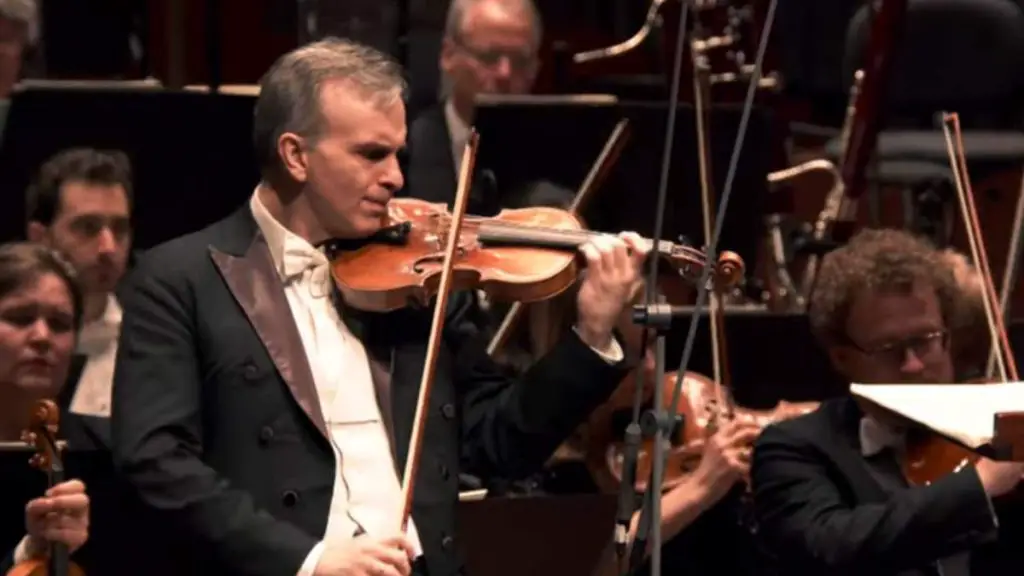Accompanied by the RTVE Symphony Orchestra (also known as the Spanish Radio and Television Symphony Orchestra), American classical violinist Hilary Hahn performs Sergei Prokofiev’s Violin Concerto No. 1 in D major, Op 19. Conductor: Víctor Pablo Pérez.
Sergei Prokofiev’s Violin Concerto No. 1
Sergei Prokofiev began his Violin Concerto No. 1 in D major, Op. 19, as a concertino in 1915 but soon abandoned it to work on his opera The Gambler.
He returned to the concerto in the summer of 1917. It premiered on October 18, 1923, at the Paris Opera with French classical violinist Marcel Darrieux (18 October 1891 – 2 September 1989) playing the violin part and the Paris Opera Orchestra conducted by the Russian-born American conductor Serge Koussevitzky (26 July [O.S. 14 July] 1874 – 4 June 1951).
The famous Russian composer, pianist, and conductor Igor Stravinsky (17 June [O.S. 5 June] 1882 – 6 April 1971) made his debut as a conductor at the same concert, conducting the first performance of his own Octet for Wind Instruments.
Prokofiev’s Violin Concerto No. 1 is in three movements. With the start times in the video:
- [00:00] Andantino. The first movement, marked Andantino and commencing in 6/8 meter, opens with a lyrical violin melody to be played sognando (dreamily) and pianissimo (very softly) over viola tremolos. The solo violin is joined in dialogue by the flutes, clarinets, and oboes. The second theme, more virtuosic and forceful, is marked narrante; David Oistrakh recalled that Prokofiev had said “play it as though you’re trying to convince someone of something.” Shifts to 4/4 time and C major serve to accentuate the contrast with the principal theme. The development begins with the soloist playing pizzicato, and proceeds to develop upon the principal theme. In a brief recapitulation, the theme is restated, not by the soloist, but by the principal flute, and accompanied elaborately by the soloist and harp.
- [09:07] Scherzo: Vivacissimo. The second movement, a scherzo marked Vivacissimo, is in rondo form. Michael Steinberg wrote that the movement “represents the savage element of the concerto as against the generally more lyrical first and third movements. The music, full of contrast, is by turns amusing, naughty, for a while even malevolent, athletic, and always violinistically ingenious and brilliant. It seems to be over in a moment.”
- [13:00] 3. Moderato – Andante. The finale of Prokofiev’s Violin Concerto No. 1, initially marked Moderato, starts with a bassoon theme over a metronomic eighth-note orchestral accompaniment. The soloist assumes the theme from the bassoon before dropping back to an accompanying role when the movement transitions to a section marked Allegro moderato. The solo violin increasingly interchanges between the roles of the soloist and the accompanist. The movement ends with the music fading away in tempo and dynamics, and quotes the ending of the first movement, concluding in almost exactly the same way.
RTVE Symphony Orchestra
The RTVE Symphony Orchestra (Orquesta Sinfónica de Radio Televisión Española), also known as the Spanish Radio and Television Symphony Orchestra is a Spanish radio orchestra servicing RTVE, the Spanish national broadcasting network.
The Orchestra is based at the Teatro Monumental in Madrid, Spain.

Sources
- Violin Concerto No. 1 (Prokofiev) on Wikipedia
- RTVE Symphony Orchestra on Wikipedia
![Sibelius: Violin Concerto [Hilary Hahn]](https://cdn-0.andantemoderato.com/wp-content/uploads/2022/09/Sibelius-Violin-Concerto-Hilary-Hahn-2010-1024x565.jpg)

